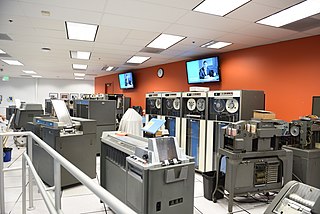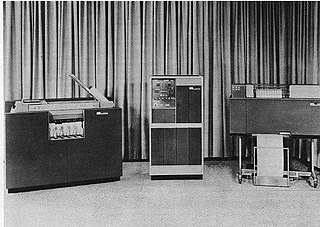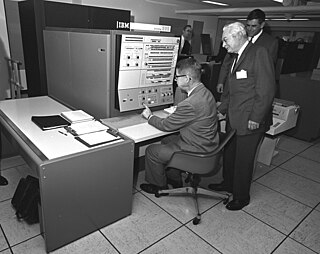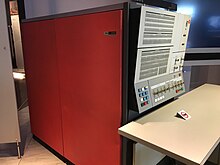A disk operating system (DOS) is a computer operating system that resides on and can use a disk storage device, such as a floppy disk, hard disk drive, or optical disc. A disk operating system provides a file system for organizing, reading, and writing files on the storage disk, and a means for loading and running programs stored on that disk. Strictly speaking, this definition does not include any other functionality, so it does not apply to more complex OSes, such as Microsoft Windows, and is more appropriately used only for older generations of operating systems.
IBM mainframes are large computer systems produced by IBM since 1952. During the 1960s and 1970s, IBM dominated the computer market with the 7000 series and the later System/360, followed by the System/370. Current mainframe computers in IBM's line of business computers are developments of the basic design of the System/360.

The IBM System/360 (S/360) is a family of mainframe computer systems announced by IBM on April 7, 1964, and delivered between 1965 and 1978. System/360 was the first family of computers designed to cover both commercial and scientific applications and a complete range of applications from small to large. The design distinguished between architecture and implementation, allowing IBM to release a suite of compatible designs at different prices. All but the only partially compatible Model 44 and the most expensive systems use microcode to implement the instruction set, featuring 8-bit byte addressing and fixed point binary, fixed point decimal and hexadecimal floating-point calculations.

The IBM System/370 (S/370) is a range of IBM mainframe computers announced as the successors to the System/360 family on June 30, 1970. The series mostly maintains backward compatibility with the S/360, allowing an easy migration path for customers; this, plus improved performance, were the dominant themes of the product announcement.

The IBM 1620 was announced by IBM on October 21, 1959, and marketed as an inexpensive scientific computer. After a total production of about two thousand machines, it was withdrawn on November 19, 1970. Modified versions of the 1620 were used as the CPU of the IBM 1710 and IBM 1720 Industrial Process Control Systems.

The IBM 1401 is a variable-wordlength decimal computer that was announced by IBM on October 5, 1959. The first member of the highly successful IBM 1400 series, it was aimed at replacing unit record equipment for processing data stored on punched cards and at providing peripheral services for larger computers. The 1401 is considered by IBM to be the Ford Model-T of the computer industry due to its mass appeal. Over 12,000 units were produced and many were leased or resold after they were replaced with newer technology. The 1401 was withdrawn on February 8, 1971.

Basic Operating System/360 (BOS/360) was an early IBM System/360 operating system.

The IBM 700/7000 series is a series of large-scale (mainframe) computer systems that were made by IBM through the 1950s and early 1960s. The series includes several different, incompatible processor architectures. The 700s use vacuum-tube logic and were made obsolete by the introduction of the transistorized 7000s. The 7000s, in turn, were eventually replaced with System/360, which was announced in 1964. However the 360/65, the first 360 powerful enough to replace 7000s, did not become available until November 1965. Early problems with OS/360 and the high cost of converting software kept many 7000s in service for years afterward.
Disk Operating System/360, also DOS/360, or simply DOS, is the discontinued first member of a sequence of operating systems for IBM System/360, System/370 and later mainframes. It was announced by IBM on the last day of 1964, and it was first delivered in June 1966. In its time, DOS/360 was the most widely used operating system in the world.

The IBM System/3 was an IBM midrange computer introduced in 1969, and marketed until 1985. It was produced by IBM Rochester in Minnesota as a low-end business computer aimed at smaller organizations that still used IBM 1400 series computers or unit record equipment. The first member of what IBM refers to as their "midrange" line, it also introduced the RPG II programming language. It is the first ancestor in the product line whose current version is the IBM i series and includes the highly successful AS/400.

The IBM 1400 series are second-generation (transistor) mid-range business decimal computers that IBM marketed in the early 1960s. The computers were offered to replace tabulating machines like the IBM 407. The 1400-series machines stored information in magnetic cores as variable-length character strings separated on the left by a special bit, called a "wordmark," and on the right by a "record mark." Arithmetic was performed digit-by-digit. Input and output support included punched card, magnetic tape, and high-speed line printers. Disk storage was also available.
The history of IBM mainframe operating systems is significant within the history of mainframe operating systems, because of IBM's long-standing position as the world's largest hardware supplier of mainframe computers. IBM mainframes run operating systems supplied by IBM and by third parties.

Transformer read-only storage (TROS) was a type of read-only memory (ROM) used between the mid-1940s to the late 1960s, prior to the common use of semiconductor ROM. TROS consisted of wires fed through and around transformer cores. The wires would register binary digits through inductance and separate wires sensing the change in current.

The IBM System/360 Model 20 is the smallest member of the IBM System/360 family announced in November 1964. The Model 20 supports only a subset of the System/360 instruction set, with binary numbers limited to 16 bits and no floating point. In later years it would have been classified as a 16-bit minicomputer rather than a mainframe, but the term "minicomputer" was not current, and in any case IBM wanted to emphasize the compatibility of the Model 20 rather than its differences from the rest of the System/360 line. It does, however, have the full System/360 decimal instruction set, that allows for addition, subtraction, product, and dividend of up to 31 decimal digits.

The IBM System/360 Model 40 was a mid-range member of the IBM System/360 family. It was announced on April 7, 1964, shipped in 1965, and withdrawn on October 7, 1977.

The IBM System/360 Model 50 is a member of the IBM System/360 family of computers. The Model 50 was announced in April 1964 with the other initial models of the family, and first shipped in August 1965 to the Bank of America.

The IBM System/360 Model 25 is a low-end member of the IBM System/360 family. It was announced on January 3, 1968, 3 years before the IBM System/360 Model 22, as a "bridge between its old and new computing systems".

The IBM System/370 Model 165 were jointly announced June 30, 1970 as "designed for ... the Seventies." That same day IBM announced the 370/195. They were the first three models of the IBM System/370 line of computers.

The IBM System/370 Model 115 was announced March 13, 1973, at that time the low-end model of the System/370 line. It was promoted as "an ideal System/370 entry system for users of IBM's System/3, 1130 computing system and System/360 Models 20, 22 and 25."
















